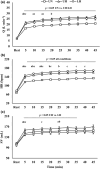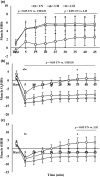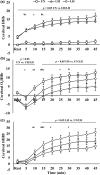Thoracic load carriage impairs the acute physiological response to hypoxia in healthy males
- PMID: 39779211
- PMCID: PMC11710892
- DOI: 10.14814/phy2.70197
Thoracic load carriage impairs the acute physiological response to hypoxia in healthy males
Abstract
To assess the impact of thoracic load carriage on the physiological response to exercise in hypoxia. Healthy males (n = 12) completed 3 trials consisting of 45 min walking in the following conditions: (1) unloaded normoxia (UN; FIO2:20.93%); (2) unloaded hypoxia (UH; FIO2:~13.0%); and (3) loaded hypoxia (LH; 29.5 kg; FIO2:~13.0%). Intensity was matched for absolute VO2 (2.0 ± 0.2 L·min-1) across conditions and relative VO2 (64.0 ± 2.6 %VO2max) across hypoxic conditions. With LH versus UH, there were increases in breathing frequency (5-11 breaths·min-1; p < 0.05) and decreases in tidal volume (10%-18%; p < 0.05) throughout exercise due to reductions in end inspiratory lung volumes (p < 0.05). Consequently, deadspace (11%-23%; p < 0.05) and minute ventilation (7%-11%; p < 0.05) were increased starting at 20 and 30 min, respectively. In addition, LH increased perceived exertion/dyspnea and induced inspiratory (~12%; p < 0.05 vs. UN) and expiratory (~10%; p < 0.05 vs. pre-exercise) respiratory muscle fatigue. Expiratory flow limitation was present in 50% of subjects during LH. Cardiac output and muscle oxygenation were maintained during LH despite reduced stroke volume (6%-8%; p < 0.05). Finally, cerebral oxygenated/total hemoglobin were elevated in the LH condition versus UH starting at 15 min (p < 0.05). Thoracic load carriage increases physiological strain and interferes with the compensatory response to hypoxic exposure.
Keywords: altitude; expiratory flow limitation; hemodynamics; near‐infrared spectroscopy; respiratory muscle fatigue; ventilation.
© 2025 The Author(s). Physiological Reports published by Wiley Periodicals LLC on behalf of The Physiological Society and the American Physiological Society.
Conflict of interest statement
The authors report no conflicts of interest.
Figures







References
-
- Ainslie, P. N. , Barach, A. , Murrell, C. , Hamlin, M. , Hellemans, J. , & Ogoh, S. (2007). Alterations in cerebral autoregulation and cerebral blood flow velocity during acute hypoxia: Rest and exercise. American Journal of Physiology. Heart and Circulatory Physiology, 292, 976–983. - PubMed
-
- Aliverti, A. (2008). Lung and chest wall mechanics during exercise: Effects of expiratory flow limitation. Respiratory Physiology & Neurobiology, 163, 90–99. - PubMed
-
- Aliverti, A. , Dellacà, R. L. , Lotti, P. , Bertini, S. , Duranti, R. , Scano, G. , Heyman, J. , Lo Mauro, A. , Pedotti, A. , & Macklem, P. T. (2005). Influence of expiratory flow‐limitation during exercise on systemic oxygen delivery in humans. European Journal of Applied Physiology, 95, 229–242. - PubMed
-
- Amann, M. , Pegelow, D. F. , Jacques, A. J. , & Dempsey, J. A. (2007). Inspiratory muscle work in acute hypoxia influences locomotor muscle fatigue and exercise performance of healthy humans. American Journal of Physiology. Regulatory, Integrative and Comparative Physiology, 293, R2036–R2045. - PubMed
-
- Amann, M. , Regan, M. S. , Kobitary, M. , Eldridge, M. W. , Boutellier, U. , Pegelow, D. F. , & Dempsey, J. A. (2010). Impact of pulmonary system limitations on locomotor muscle fatigue in patients with COPD. American Journal of Physiology. Regulatory, Integrative and Comparative Physiology, 299, R314–R324. - PMC - PubMed
MeSH terms
Grants and funding
LinkOut - more resources
Full Text Sources
Miscellaneous

